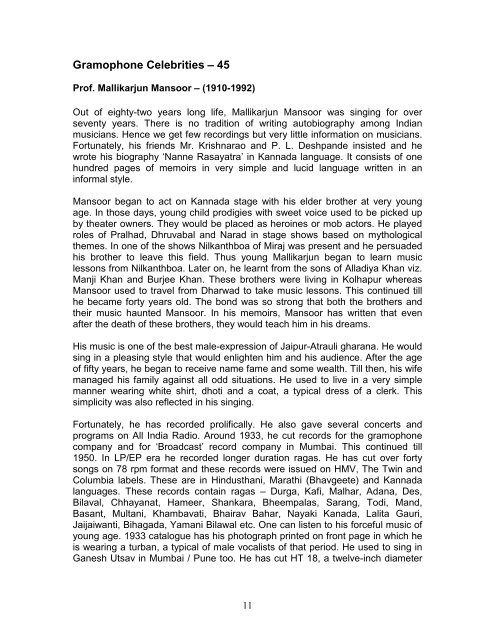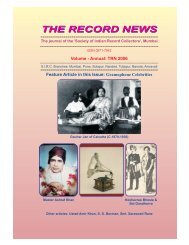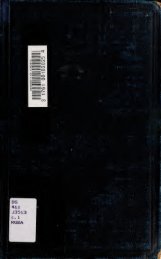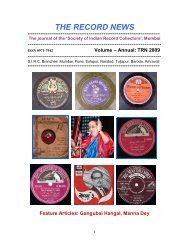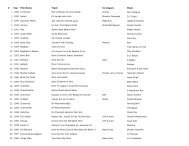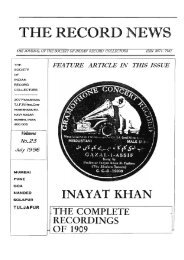THE RECORD NEWS - The Digital South Asia Library - University of ...
THE RECORD NEWS - The Digital South Asia Library - University of ...
THE RECORD NEWS - The Digital South Asia Library - University of ...
Create successful ePaper yourself
Turn your PDF publications into a flip-book with our unique Google optimized e-Paper software.
Gramophone Celebrities – 45<br />
Pr<strong>of</strong>. Mallikarjun Mansoor – (1910-1992)<br />
Out <strong>of</strong> eighty-two years long life, Mallikarjun Mansoor was singing for over<br />
seventy years. <strong>The</strong>re is no tradition <strong>of</strong> writing autobiography among Indian<br />
musicians. Hence we get few recordings but very little information on musicians.<br />
Fortunately, his friends Mr. Krishnarao and P. L. Deshpande insisted and he<br />
wrote his biography ‘Nanne Rasayatra’ in Kannada language. It consists <strong>of</strong> one<br />
hundred pages <strong>of</strong> memoirs in very simple and lucid language written in an<br />
informal style.<br />
Mansoor began to act on Kannada stage with his elder brother at very young<br />
age. In those days, young child prodigies with sweet voice used to be picked up<br />
by theater owners. <strong>The</strong>y would be placed as heroines or mob actors. He played<br />
roles <strong>of</strong> Pralhad, Dhruvabal and Narad in stage shows based on mythological<br />
themes. In one <strong>of</strong> the shows Nilkanthboa <strong>of</strong> Miraj was present and he persuaded<br />
his brother to leave this field. Thus young Mallikarjun began to learn music<br />
lessons from Nilkanthboa. Later on, he learnt from the sons <strong>of</strong> Alladiya Khan viz.<br />
Manji Khan and Burjee Khan. <strong>The</strong>se brothers were living in Kolhapur whereas<br />
Mansoor used to travel from Dharwad to take music lessons. This continued till<br />
he became forty years old. <strong>The</strong> bond was so strong that both the brothers and<br />
their music haunted Mansoor. In his memoirs, Mansoor has written that even<br />
after the death <strong>of</strong> these brothers, they would teach him in his dreams.<br />
His music is one <strong>of</strong> the best male-expression <strong>of</strong> Jaipur-Atrauli gharana. He would<br />
sing in a pleasing style that would enlighten him and his audience. After the age<br />
<strong>of</strong> fifty years, he began to receive name fame and some wealth. Till then, his wife<br />
managed his family against all odd situations. He used to live in a very simple<br />
manner wearing white shirt, dhoti and a coat, a typical dress <strong>of</strong> a clerk. This<br />
simplicity was also reflected in his singing.<br />
Fortunately, he has recorded prolifically. He also gave several concerts and<br />
programs on All India Radio. Around 1933, he cut records for the gramophone<br />
company and for ‘Broadcast’ record company in Mumbai. This continued till<br />
1950. In LP/EP era he recorded longer duration ragas. He has cut over forty<br />
songs on 78 rpm format and these records were issued on HMV, <strong>The</strong> Twin and<br />
Columbia labels. <strong>The</strong>se are in Hindusthani, Marathi (Bhavgeete) and Kannada<br />
languages. <strong>The</strong>se records contain ragas – Durga, Kafi, Malhar, Adana, Des,<br />
Bilaval, Chhayanat, Hameer, Shankara, Bheempalas, Sarang, Todi, Mand,<br />
Basant, Multani, Khambavati, Bhairav Bahar, Nayaki Kanada, Lalita Gauri,<br />
Jaijaiwanti, Bihagada, Yamani Bilawal etc. One can listen to his forceful music <strong>of</strong><br />
young age. 1933 catalogue has his photograph printed on front page in which he<br />
is wearing a turban, a typical <strong>of</strong> male vocalists <strong>of</strong> that period. He used to sing in<br />
Ganesh Utsav in Mumbai / Pune too. He has cut HT 18, a twelve-inch diameter<br />
11


